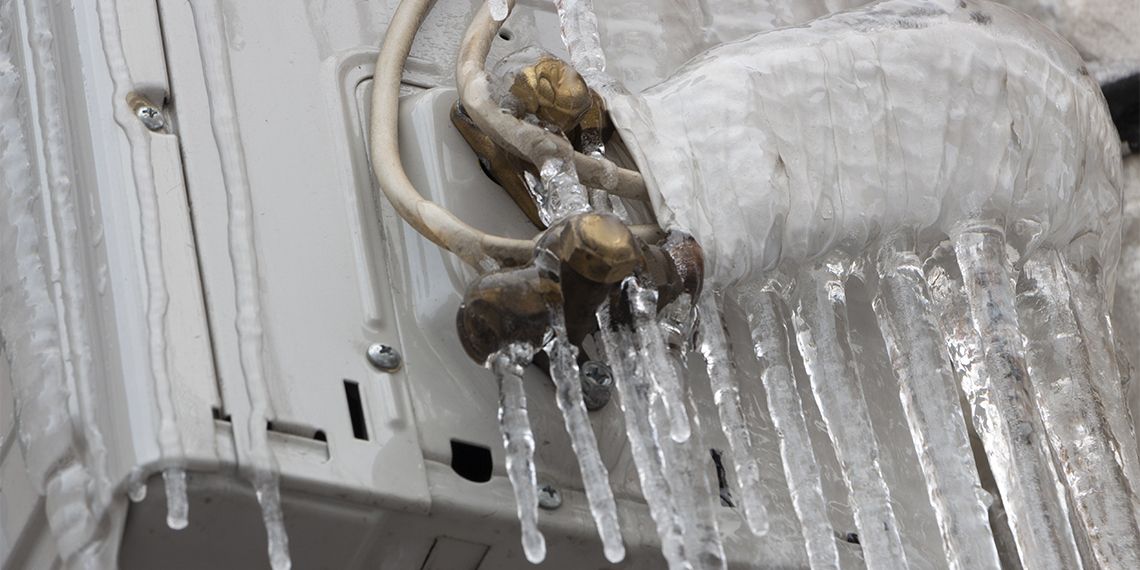Tips for Thawing a Frozen AC Pipe - Restoring Proper Operation
Tips for Thawing a Frozen AC Pipe - Restoring Proper Operation
Blog Article
Just about every person is bound to have their private conception about Have a Frozen AC Line? Here’s How to Fix It.

Intro
Finding that your air conditioning pipeline is iced up can be concerning, particularly during hot summertime when you depend on your air conditioning unit the most. Understanding what to do in such a circumstance is vital to prevent further damage to your cooling system and ensure your comfort indoors.
Understanding the Causes
Several elements can contribute to the freezing of an AC pipeline. Understanding these reasons can assist you resolve the concern properly.
Absence of Airflow
One common source of an icy AC pipe is inadequate airflow. When the air movement over the evaporator coil is limited, it can trigger the coil to go down below freezing temperature, causing ice formation on the pipe.
Reduced Refrigerant Levels
Inadequate cooling agent degrees in your AC system can also result in a frozen pipe. Reduced cooling agent degrees can trigger the pressure in the system to drop, bring about the cold of wetness on the evaporator coil.
Cold Weather Conditions
In cooler climates, freezing temperatures outside can contribute to the freezing of air conditioning pipelines. If your a/c device is not effectively insulated or if there are leakages in the ductwork, chilly air can penetrate the system, creating the pipeline to freeze.
Dirty Air Filters
Dirty or clogged up air filters can limit air movement in your air conditioner system, causing different problems, including an icy pipe. It's necessary to change or clean your air filters routinely to guarantee correct air flow and prevent ice accumulation.
Indicators of a Frozen Air Conditioner Pipe
Identifying the signs of a frozen air conditioner pipeline is critical for prompt action.
Minimized Airflow
If you notice a substantial decrease in air movement from your vents, it can show a frozen pipe.
Ice Buildup on the Pipe
Noticeable ice accumulation on the refrigerant line or the evaporator coil is a clear sign of an icy a/c pipeline.
Strange Sounds from the Unit
Uncommon audios, such as hissing or bubbling, originating from your a/c unit can signify that there's ice present on the pipe.
Immediate Actions to Take
When confronted with an icy air conditioner pipeline, it's vital to act swiftly to prevent further damages to your air conditioning system.
Turning off the a/c
The initial step is to switch off your air conditioner to avoid the system from running and exacerbating the problem.
Checking for Blockages
Check the location around the indoor device for any type of blockages that may be obstructing airflow, such as furniture or drapes.
Thawing the Pipe
You can use mild techniques like positioning towels soaked in cozy water around the frozen pipe to assist thaw it slowly.
Preventive Measures
Taking safety nets can assist stay clear of future events of an icy air conditioning pipeline.
Normal Maintenance Checks
Arrange routine upkeep contact an expert HVAC service technician to make sure that your air conditioner system is running effectively.
Transforming Air Filters
Frequently replace or cleanse your air filters to stop air movement limitations and preserve ideal performance.
Insulating Exposed Pipes
If your a/c pipelines are exposed to cold temperatures, consider protecting them to avoid freezing throughout winter season.
Seeking Professional Help
If DIY approaches fail to fix the problem or if you're uncertain concerning how to proceed, it's ideal to look for support from a qualified HVAC specialist.
When DIY Methods Fail
If your efforts to thaw the pipeline or address other problems are not successful, it's time to contact a professional.
Significance of Hiring a Professional HVAC Technician
A qualified HVAC professional has the proficiency and tools needed to diagnose and fix issues with your a/c system safely and efficiently.
Conclusion
Taking care of a frozen air conditioner pipeline can be an irritating experience, yet knowing how to respond can assist minimize damage and bring back convenience to your home. By comprehending the reasons, identifying the signs, and taking punctual action, you can effectively attend to the issue and prevent future incidents.
Frozen AC Line: Why It Happens & What To Do About It
A frozen AC line can be a rather peculiar sight in a place like Phoenix, Arizona where nothing ever freezes. In this post, we’ll discuss what makes an air conditioner line frozen – and what you can do about it.
Dirty Air Filters
Did you know that you should be cleaning or replacing your air filters on a monthly basis? Failing to do this can result in airflow issues that, in turn, cause your evaporator coils and lines to freeze over. You’ll notice a buildup of ice on both components, although the buildup on your pipes will, of course, be more evident unless you open your air condition up to reveal the coils.
What To Do About It
Give your air filter a good cleaning if it’s reusable. If not, replace the filter outright. Next, switch your air conditioner’s fan setting on and leave it there for 2-3 hours. This will draw warm air in, helping to thaw your evaporator coil. You can also check out this article for some tips on cleaning the coils themselves if you’d like to speed the process up. Before you switch the unit back to its normal state, make sure the supply vents are completely unobstructed and free of dust or other debris.
If you keep having this issue even after replacing your filters regularly, contact a local HVAC repair company and have them inspect your evaporator coil, ductwork, and any other components that may be at fault. If you live in the Phoenix, Arizona area, give American Home Water and Air a call.
Low Refrigerant Levels/Leakage
What To Do About It
Contrary to what air conditioner “recharge” companies often tell their clients about refrigerant, it should never need to be simply refilled. You see, refrigerant runs in what experts refer to as a “closed loop.” Refrigerant really shouldn’t be leaving that loop. If it is, you’ve got a leak.
Paying someone to come and pump more refrigerant into your system (aka “recharge” it) isn’t the solution. Doing that will simply kick the can down the road. Besides, refrigerant leaks can be harmful to the environment and people in your home.
Rather, you need to take care of the leak with the help of a technician. Check out this article for some more information about dealing with air conditioners that are leaking refrigerant. Before you contact a technician, switch your thermostat to the off position. Then, switch the fan setting on and let it run for 2-3 hours so the unit can thaw.
Improper Temperature Setting
Improper temperature settings can also cause a drop in your air conditioner’s pressure. What many people don’t realize is that air conditioners are actually designed to run when temperatures have fallen above roughly 60 degrees Fahrenheit. If you run the unit when it’s cold outside, you’ll run into many issues, including frozen components.

Do you really like reading about Why Is Ice On My Outside Air Conditione? Write a short review down the page. We'd be glad to know your responses about this posting. We hope to see you back again before long. Sharing is caring. Helping people is fun. Thank you for going through it.
Suggested Site Report this page